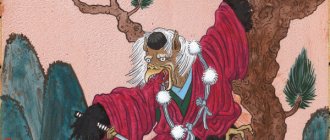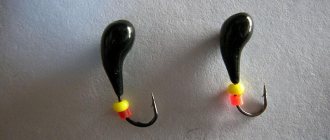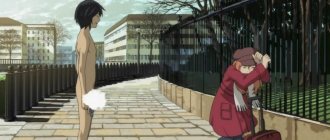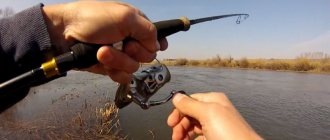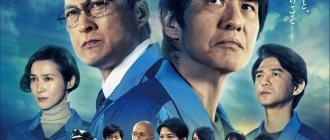Time and place of action - Japan during the Tokugawa shogunate
At the beginning of the 18th century, Japan was a feudal society with a rather unusual way of life for us. The fact is that the country, while the emperor was alive, was ruled by a shogun - something like the commander-in-chief of the troops. Formally, he recognized the power of the monarch over himself, who was considered the son of the goddess Amaterasu. However, the shogun made all important decisions himself, without regard to the opinion of the divine descendant.
During the events described, the country was ruled by Tokugawa Tsunayoshi, an eccentric shogun who combined Confucianism and Buddhism in his worldview, albeit in an outlandish way. From Confucianism he took a love for the ritualization of everyday life, so the courtiers were obliged to thoroughly know all the ceremonies and in no case make mistakes in the small details of clothing or behavior.
"The Dog Shogun" by Tokugawa Tsunayoshi.
From Buddhism, Tokugawa took compassion for living beings, although he understood it rather strangely. Tsunayoshi received his nickname “Dog Shogun” for good reason. On pain of death, he forbade his subjects to beat and even more so kill stray dogs. If a dog climbed onto a peasant’s plot, he did not even have the right to shout at the dog, but had to politely ask him to leave. For the slightest harm to the dogs, the peasant could be deprived of his life. And once, because of such an incident, an entire village was executed.
Naturally, stray dogs multiplied at an alarming rate and wild packs began to attack people, for which the people did not particularly like their ruler. By the way, you can read about how the story with Tsunayoshi ended in our other article.
Oath of Vengeance
The samurai who had lost their rank gathered for a council after receiving this news. Some of them suggested looking for a new overlord, some - committing ritual suicide. A third of the ronin, 47 to be exact, decided to first avenge the death of their daimyo. They were sure that Kira Yosinaka did not receive due punishment, and perhaps even deceived the shogun.
Meghan Markle is expecting her second child. There will be a new addition to the prince's family
Mannequins were developed for 2.5 million rubles. for training medical personnel
Antibodies to the rescue: one vaccine will be enough for those who have already recovered from COVID
Yoshinaka, realizing that he played an important role in the death of Naganori, expected attempts at revenge and therefore significantly increased his security and moved to the fortress.
The beginning of the conflict
Asano Naganori. Key character in the story.
It was to the court of this ceremonial-obsessed shogun that the main characters were invited - daimyo Asano Naganori, a feudal lord from Ako, as well as a daimyo named Kamei Sama. They were quite inexperienced in terms of ceremonies, so they were immediately assigned to a local high-ranking official named Kira Yosinaka, who was famous not only for his bad temper, but also for his greed.
The gifts that Kira received from his two students did not satisfy him, and he began to harass them with nagging and even outright insults. The official openly took advantage of his position and the fact that for displaying weapons in the shogun’s chambers, the guilty person faced not only the death penalty, but also shame that fell on his entire family.
Kira tried to lure out even bigger gifts with attacks. The daimyo only tolerated it, but at some point one of the sufferers, Kamei Sama, could not stand it and told his people that he was ready to kill the presumptuous official. His people consulted and decided to chip in and bring gifts to the master of ceremonies. Kira immediately showed his corruption by immediately changing his attitude towards Kamei: he began to speak politely to him and even apologized for his past rudeness - a typical extortionist.
But another daimyo, Asano Naganori, did not think of bribing the official again, which ultimately cost them both their lives. One day, Asano could not stand it and, after he was once again called an “uncouth hillbilly,” he either pulled out a sword and cut Kira’s face, or poked him in the eye with the knife he brought. Details of the story vary.
Asano Naganori attacks Yoshinaka.
The attack failed, Kira escaped with only minor wounds, but dark times came for Asano and his family. The daimyo himself was sentenced to ritual suicide by the enraged shogun, and his samurai, having lost their master, became ronin - wandering warriors. The Asano family was deprived of the clan name and property, as disgraced by the act of the head of the clan.
Cast[edit | edit code]
| Actor | Role |
| Keanu Reeves | Kai |
| Tadanobu Asano | Lord Kira Yoshinaka |
| Hiroyuki Sanada | karo Oishi Yoshio Kuranosuke |
| Min Tanaka | Lord Asano Naganori |
| Ko Shibasaki | Mika daughter of Lord Asano |
| Cary-Hiroyuki Tagawa | Shogun Tokugawa Tsunayoshi |
| Jin Akanishi | Oishi Chikara son of Yoshio Kuranosuke |
| Rinko Kikuchi | Mizuki |
| Masayoshi Haneda | Yasuno |
| Haruka Abe | maid Miki |
| Yorick van Wageningen | Captain |
| Togo Igawa | lord of the tengu |
| Yuriri Naka | Ica |
| Rick Genest | master |
Ronin get down to business
Ronins are somewhat similar to landless knights in Europe, but with their own characteristics. These were samurai who had lost the patronage of their master, and therefore their permanent income. They could become traders (but this was considered a shameful thing for warriors), or they could become free poets or musicians. The latter, however, required talent, and not everyone had it. However, more often than not, a poor and restless warrior became a robber or hired killer, so ronins were not particularly favored in Japan at that time.
After Asano's execution, about two hundred samurai remained, who unexpectedly became ronin. And if the majority accepted this fate, then forty-seven, led by adviser Oishi Kuranosuke, decided that the honor of the master requires vengeance. At the same time, they understood perfectly well that after revenge they would face inevitable execution, but they went for it, guided by the Bushido code, the rules of samurai behavior.
Having taken up the matter, the disgraced warriors, first of all, hid, because Kira perfectly understood that they could take revenge and was constantly under guard. To disguise themselves, the ronins dispersed throughout Japan, leading a riotous lifestyle. Oishi himself divorced his wife, took a concubine and constantly spent his time drinking, wallowing in the mud, and people passing by showered him with contemptuous ridicule.
One man from the Satsuma principality completely called the former adviser a fool and a bastard, unworthy of the title of samurai, kicking the sleeping man and spitting right in his face. Naturally, rumors about such behavior of possible avengers reached Kira, and over time he relaxed, no longer devoting so much effort to protecting his person. But in vain.
Links[ | ]
- FORTY SEVEN RONIN // Japan from A to Z. Popular illustrated encyclopedia. (CD-ROM). - M.: Directmedia Publishing, "Japan Today", 2008. - ISBN 978-5-94865-190-3.
- "47 Loyal Samurai" in prints by Utagawa Kuniyoshi Archived copy of January 17, 2013 on the Wayback Machine
To improve this article it is desirable:
Please, after fixing the problem, remove it from the list of parameters. After eliminating all the shortcomings, this template can be deleted by any participant. |
Revenge of the Forty-seven Ronin
On January 30, 1703, two detachments of ronin, at the signal of a drum, burst into the estate of Kira Yoshitaka in the city of Edo, killing sixteen and wounding more than twenty people along the way.
It was decided to break the gate with an ax, and so that the surrounding people would not worry, messengers were sent to them with literally the following message:
“We, ronins, who were formerly in the service of Asano Takumi no Kami, are going to break into the palace of Kira Kozuke no Suke this night to avenge our master. We are not night burglars or hooligans and will not harm neighboring houses. Please do not worry."
Also, there is a legend according to which ronin, in order to distinguish each other in the dark, tied their heads with white cloth, and now in Japan such headbands are considered a sign of decisive intentions, called “Hachimaki”, and are worn before an attack to raise morale.
Hearing the noise, Kira, along with his children and wife, hid in the closet, and for a long time they could not find him. However, Oishi still found his secret hideout and, announcing that he had come to avenge his master, invited Kira to commit seppuku for himself. He refused, after which his head was simply cut off.
Having gathered together, the ronin with Kira's severed head in a bucket marched solemnly through Edo. Having taken their bloody trophy to the Buddhist monastery, to the grave of the owner, they surrendered to the authorities and sent the youngest as a messenger to Ako to report the retribution that had taken place.
The True Story of the 47 RoninMemory History and Events
The thirtieth of January 1703 went down in Japanese history thanks to forty-seven ronin who committed an act of revenge. Simply put, they took revenge on their master's murderer. This story has become a real treasure of Japan. It formed the basis of the legend, numerous kabuki theater productions and film adaptations, many of which were completely removed from real events. The ending of the story, which was later destined to become a classic for Japan, occurred at the beginning of 1703. But it itself began in 1701. According to Japanese tradition, the bakufu - the shogunal government - sent representatives to Kyoto at the beginning of each calendar year. Here, in the capital, the envoys congratulated the emperor on the upcoming holiday and presented gifts. And after some time, envoys from the ruler (as well as the previous monarch) went on a return visit to the shogun. By and large, there was no sense in this exchange of pleasantries, but the Japanese were very careful about their traditions, elevating them to the absolute. All persons involved in the ceremony (from large feudal lords to ordinary servants) underwent thorough and meticulous instruction. The shogun did not allow himself to even entertain the thought that something could go wrong. For a person who made the slightest mistake during the ceremony, everything could end in disaster.
The first visit (to Kyoto) went off without a hitch.
The higher authorities were pleased. After some time, three ambassadors arrived in Edo. One of them represented Reigen-joko - the former emperor, the rest were envoys of the Higashiyama-tenno in power. The latter were entrusted with meeting the daimyo (the class of the largest military feudal lords who were considered the elite among the samurai) Asano Naganori. And the representative from the former ruler was entrusted to the head of the Yoshida clan - Date Kikyo no suke Mu nehar. The guests arrived in Edo for several days. First they met with the shogun, then attended a Noh theater performance that was prepared especially for them. The hanging was to be completed by a thank-you ceremony and the presentation of gifts from the shogun and his wife to the ambassadors representing the authorities. Asano Naganori
It was assumed that the final chord of the meeting would take place in the White Office of the Shogun Palace at nine o'clock in the morning. But it didn’t come to that.
The white office in the shogun's castle was connected to the Reception Hall by a special pine corridor. It got its name due to the fact that its sliding partitions that formed the walls (fusuma) were decorated with an image of a seashore densely overgrown with pine trees.
Naturally, in the morning the corridor was full of people. The distinguished guests were about to move along the pine landscapes to the White Office. Kajikawa Yoriteru, the head of the palace guard, had his finger on the pulse. He understood that if something went wrong, only he would have to answer. After examining the corridor, he headed towards the White Office to check it too, just in case. But I didn’t get there. He met Kira Yoshinaka, the chief master of ceremonies at the shogun's court (this position was called "koke"). Kira was just heading out of the White Office. The men stopped to share with each other their impressions of the meeting with the emperors' ambassadors. As soon as they started talking, the daimyo Asano Naganori suddenly heard an exclamation: “Do you remember about my hatred of you just now?!” After these words, he hit Cyrus on the head with his sword. And he didn’t miss. The blade landed directly on the koke's forehead. Asano then hit him several more times and then tried to escape. But Kira remained alive. Moreover, the blows did not cause him any significant damage. And this, of course, is strange. Experienced and skilled, Asano had excellent command of weapons. Some researchers believe that Naganori's failure is due to the fact that instead of a real combat sword, he used a “toy” - a small blade. The fact is that the carrying of real military weapons in the shogun’s chambers was strictly prohibited. And the daimyo did not dare to break this rule. Which, according to some researchers, is also strange. They believe that Asano could not have been unaware of the futility of an attack with a “toy” weapon. True, other researchers believe that the daimyo did not hatch a plan to assassinate his old enemy. This decision was spontaneous and thoughtless.
One way or another, Asano committed an assassination attempt and tried to escape. But it didn’t work out; the vigilant security chief Kajikawa managed to grab him. The noise attracted the attention of the guards themselves. The daimyo was disarmed and placed under arrest in the Willow Room. Soon Shogun Tsunayoshi also learned about the incident. And on his orders, Asano was taken under escort to Tamura Ukyodayu’s mansion. Here the criminal had to wait for news about his unenviable fate. But the future did not scare him. He knew perfectly well that he would not be able to survive. The main thing is the death of the hated Kira. The daimyo did not know that the enemy had survived and periodically whispered: “Now he has taken revenge!”
About two hours have passed since the assassination attempt. Asano was in custody, and an emergency meeting was held at the shogun's castle. It was headed, of course, by Tsunayoshi personally. There was only one question on the agenda - how to punish Asano for the crime? After a short meeting, the shogun rendered a verdict - the daimyo was obliged to commit seppuku. Asano received this news with enthusiasm. And in the evening of the same day he was gone.
Of course, the shogun handed down a very severe sentence, but the crime committed by Asano was classified as “serious.” An aggravating circumstance was the fact that he was “of sober mind and strong memory.” Therefore, not only the daimyo himself was punished, but also his entire clan. All of Asano's possessions were confiscated. In general, the daimyo paid too high a price for the blow to the forehead and right shoulder. He himself passed away, his clan was disbanded, and all the samurai who served Naganori overnight turned into ronin. That is, they will lose their owner, work and livelihood. It’s an unenviable lot, I must say.
* * *
None of the ronin could give an exact answer as to why Asano sacrificed everything to try to kill Kira Yoshinaka?
Yes, they were at enmity, but it never came to an open confrontation. And suddenly this. True, in one of the documents of that time, the reasons why Asano drew his sword are still mentioned.
Samurai Asahi Bunzaemon, in a diary entitled “Notes from a Parrot's Cage,” believed that Asano was provoked by Kira himself. Asahi wrote that traditionally the daimyo, who was entrusted with welcoming ambassadors, received a set of rules from Yoshinaka. In principle, they were not mandatory, but everyone understood that it was better not to neglect them. Naturally, Kira did not take payment for his services, but expected expensive gifts. But Asano decided to go against the established tradition. He did not give Kira gifts. He took this as an insult and, accordingly, did not give Asano any recommendations. This is how, in Asahi’s opinion, the conflict between these men broke out. The situation was aggravated by the fact that Asano, of course, made several mistakes while receiving the envoys. And he blamed Kira for his shame. Yoshinaka also did not think of keeping silent. He added fuel to the fire by saying that Asano had ruined everything with his behavior. Immediately rumors spread, the daimyo heard people whispering, saw their glances and ridicule. He felt that his reputation was tarnished and therefore decided to commit a crime. This version is adhered to by the author of “True Notes on the House of Tokugawa” and even by the Kabuki theater. Ukiyo-e depicting Asano Naganori attacking Kira Yoshinaka, at Edo Castle
After Asano committed suicide, his many retainers were faced with a difficult choice. They gathered at Ako Castle to decide their fate. Some argued that it was necessary to go in search of a new owner, others voted for suicide after the master. There was also a third party. These vassals were not going to look for a new “employer”; the warriors were not eager to leave this life. They declared that Asano must be avenged. After disputes, forty-seven ronin under the leadership of Oishi Kuranosuke separated from the mass of vassals. True, at first there were much more thirsty for the blood of Kira Yoshinaka, but gradually the composition of the “loyal vassals” was reduced to forty-seven people. These ronins were included, so to speak, in the “canonized” version of subsequent events.
* * *
The desire to avenge the master is, of course, a noble cause. But bringing the plan to life was not so easy. The fact is that Kira, of course, learned that some of the vassals had taken the path of revenge. The news of the impending assassination attempt became an open secret. Kira, his Uesugi clan and all the officials who were part of the shogun government knew about him. Accordingly, the ronin began to be closely watched. Oishi understood the complexity of the ronin's situation. Therefore, he decided to use a trick - to disperse people and prohibit them from directly communicating with each other. Yes, precious time was lost, but the likelihood of success of the plan increased. Oishi himself moved to his relatives and settled in Yamashina, in the northern part of Kyoto. Here the leader of the ronins began to develop a plan for revenge. But things went slowly. He knew that Kira had taken enhanced precautions and had greatly increased security. After some thought, Oishi came to the conclusion that it would definitely not be possible to eliminate Kira in the near future - the ronin were under cover. Therefore, he decided to deceive everyone. Oishi suddenly left Yamashina and moved to Kyoto, settling in the Gion district. Here, as a diversion, the ronin began to depict a moral decline, pretending that Asano’s death had broken him. Kuranosuke spent almost all his time in entertainment establishments, especially in Ichiriki. He drank a lot, was fond of gambling and told his drinking buddies about his unenviable fate. It is clear that all this was just a re-enactment for Kira’s agents, who were watching his every move. At first no one believed him. Yoshinaka was not so stupid, but after a while doubt appeared in his soul. The same seeds sprouted in the souls of the other ronins. The fact is that Oishi did not let anyone in on the details of his cunning plan. When Kira heard rumors that Kuranosuke had finally turned into a morally corrupt alcoholic, from whom even his friends had turned their backs, Yoshinaka gave the order to curtail surveillance, and at the same time reduce the number of his guards. The chief master of ceremonies had no doubt that the former daimyo no longer posed a real danger to him. Thus, Oishi was able to brilliantly implement the first part of the plan. After waiting some more time to be convincing, Kuranosuke contacted the ronin and explained everything to them. After this, he ordered them to secretly, under fictitious names, move to Edo and settle in houses near the mansion of Cyrus. And soon the second part of the plan began to be implemented. Ronins, one after another, began to move to Edo and, following the legend, opened their own businesses. For example, it is known that Horibe Yasubei, who took the pseudonym Nagae Chozaemon, rented a room and began teaching fencing. Other ronins were engaged in business and monitored Kira's movements around the city. They drew up a detailed plan of his routes, indicating the time. At the same time, the warriors watched the enemy’s mansion, finding out his way of life. Kanzaki Yogoro Noriyasu was appointed in charge, who placed his orange shop directly at the main entrance to Yoshinaka’s house. Tomb of Asano Naganori at Sengaku-ji Temple in Edo
But to implement the Axis plan, one more important detail was required - the plan of the mansion. The Ronins needed to know exactly where to hit, because they most likely would not have had time to correct the mistake. According to legend, Okano Kanehide managed to get the necessary “piece of paper”. This version found support both in plays and in poetry. But many researchers are sure that another ronin, Okano Kanehide, got hold of the plan. But that diagram was outdated, since Cyrus’s mansion was rebuilt quite often, and there were many inaccuracies in it. But in the situation in which the ronins were, this was a real gift of fate.
After some time, the warriors managed to find out that Yoshinaka, who was a real fan of the tea ceremony, was friends with a certain Yamada Sorin, a master of preparing this drink. And his house was located not far from the mansion of Cyrus. The Ronins were lucky; among them there was one person who also knew a little about this science. It turned out that Otaka Gengo, before becoming a warrior, learned the wisdom of the tea ceremony and was, as they say, in the know. Oishi delegated him to Yamada as a student. Otaka needed to find out by hook or by crook when Kira would decide to organize her next ceremony. And the ronin completed his task. After some time, he reported to Oishi that the tea party should take place on the fourteenth day of the twelfth month. At the meeting, the ronin decided that it was on this night that they would pay Kira a “courtesy” visit.
The interesting thing is this: despite all the precautions taken by the vassals of the late Asano, government officials in Edo can be said to have known about the impending assassination attempt on Yoshinaka. The government spy network kept reporting on the strange movements of the ronin. Most likely, the authorities also knew that they “occupied” the territory near Kira’s mansion, hiding under false names. But no measures were taken to protect coke. Most likely, the authorities secretly sympathized with the “loyal vassals”, so they decided not to interfere. After all, the officials understood perfectly well that revenge for the dead master was the sacred duty of his warriors. And this sacred duty was, perhaps, the pinnacle of samurai ethics.
Preparations for the attack were in full swing. And not one of the forty-seven ronins had the desire, as they say, to “jump off.” And although they all understood perfectly well that after Yoshinaka they themselves would die (although they still had hope of salvation), there was no doubt about the correctness of the chosen path. Loyalty to his master came first, putting the instinct of self-preservation on both shoulder blades.
By order of Oishi, the ronins were divided into two groups. One went to the main gate, the second to the back. According to legend, Asano's vassals, in order to outwit the guards, put on firefighter costumes, which were distinguished by a special “mountain pattern.” And although some researchers doubt the veracity of this version, this is what the kabuki theater adheres to, as well as the famous gavryura ukiyoe. And in principle, the decision of the ronins to pose as firefighters was quite logical and far-sighted. The fact is that it was impossible to get close to Kira’s house unnoticed with a weapon in hand, as well as with the necessary equipment for an assault. And with hooks, chain ladders and ropes, only firefighters could move freely. In addition, they were allowed to move around Edo wearing chain mail and helmets. The fact is that in Japanese society of that time, firefighters occupied a special position and enjoyed all sorts of privileges. Only a representative of the military class could become a firefighter. In cities consisting of wooden buildings, firefighters were everyone's favorites and real heroes. None of Kira's guards would dare stop them for a conditional "document check." In general, the image of fire fighters was ideal for ronin.
Thanks to their firefighter uniforms, Oishi and his warriors were able to approach Yoshinaka's mansion unhindered.
On a signal, they attacked him from both sides at four o'clock in the morning. Naturally, no one expected the attack, and the ronins dealt with the half-asleep guards quite easily. The first part of the plan was carried out flawlessly. Now all that remained was to carry out the second just as brilliantly - to find and kill Kira. The ronins dispersed throughout the mansion, checking all the rooms, but they could not find the koke. True, Yoshinaka still couldn’t escape his fate. He hid in the storeroom where coal was stored and tried to pass himself off as one of the many servants, becoming thoroughly dirty with dust and dirt. But the ronins still managed to recognize him. What gave Kira away were the scars on his head left after Asano's blows. The conversation with the coke was short. He was tied up and beheaded. Thus revenge was carried out. It is known that none of the ronin died during the attack on Yoshinaka's mansion, only a few received minor injuries. And the attackers, in addition to Kira, killed sixteen guards. Naturally, the noise and screams from Kira's house attracted the attention of the neighbors. Some even tried to find out what happened. But when they found out the reason, they retreated. No one had any desire to interfere. Firstly, people were afraid for their lives, and secondly, almost everyone sympathized with the ronins and understood that revenge is sacred. Monument at the site of the large pine corridor in Edo Castle, where Asano Naganori wanted to kill Kira Yoshinaka
Two hours later, Yoshinaka’s house was empty. The soldiers of the Uesugi clan, to which Kira belonged, were late. By the time they appeared, the ronin were already near the Ekoin Temple, which was located not far from Yoshinaka’s mansion. Here they rested a bit and moved on. Before continuing their journey, Oishi ordered Yoshida Kanesuke and Tomonomori Masayori to come to Sengoku, the chief police officer in Edo, and tell them that Asano had been avenged. The remaining ronin easily reached the Sengakuji Monastery, where the grave of their master was located. And after reading the necessary prayers, the vassals placed the severed head of Kira near her. According to the original plan, the ronin were supposed to commit seppuku after this, but it did not come to that. They informed the abbot of the monastery about their plans, and he informed his superiors. Ultimately, the ronin were simply arrested and their weapons were taken away.
Determining the fate of Asano's vassals was much more difficult than choosing a punishment for their master. The proceedings dragged on for more than a month and a half. And if Japanese society, for the most part, was on the side of the ronin, then a split formed in the government. The people insisted that Oishi and his warriors were the embodiment of true loyal vassals and they could not be executed. Many influential officials were also on the side of the ronins. For example, Education Minister Hayashi Nobuatsu. They were also supported by scientists Muro Kyuso, who even wrote “Notes on Devoted People from Ako.” Many representatives of Confucianism also sympathized with the vassals. Moreover, they demanded an amnesty. Of course, there were also plenty of opponents. And they started not from feelings and emotions, but from the law. The fact is that while preparing revenge, the ronins created a real underground organization. And this was a serious crime leading to the death penalty. Accordingly, the vassals of the late Asano, if you follow the letter of the law, were full-fledged criminals. And it no longer mattered that they were fulfilling their sacred duty. This point of view was held by the statesman and scientist Ogyu Soray, the author of the Treatise on the Forty-Six Samurai of Ako and Soray's Notes on False Laws. Other opponents of the ronin have spoken out about their, shall we say, “wrong” behavior after the murder of Kira. They believed that Oishi and company had to commit suicide immediately in order to continue the tradition of holy vengeance to the end. But they simply allowed themselves to be arrested first, and then began to wait for the government’s decision. This looked shameful and low for the samurai, who did not have to think about saving their lives.
The opponents also had one more clue. They argued that the ronin had been hatching the plan for revenge for too long, rather than trying to carry it out immediately after the death of their master. It took them almost two years to prepare alone. This is too long, because during this time anything could happen to Kira.
The government was, so to speak, between Scylla and Charybdis. On the one hand, the authorities sympathized with the ronins, on the other hand, they could not break the law for their sake. And, in the end, the decision was announced: the ronin had to commit seppuku. It must be said that this verdict was quite lenient. Oishi and company could have been executed as ordinary criminals, but they were still pitied and allowed to die with dignity (such death for serious crimes was prescribed only to daimyo).
And on March 20, 1703, the ronins carried out the sentence.
It must be said that forty-six people committed seppuku. But Terazaka Kitiemon escaped death. According to legend, Oishi ordered him to go to Hiroshima to visit his younger brother Asano immediately after the murder of Yoshinaka. And since he was a simple infantryman, the bakufu, in fact, did not even try to find him. He survived, and as an eyewitness to the “sacred vengeance” he described the events that took place in two works: “The Notes of Terazaka Kitiemon” and “The Personal Notes of Terazaka Nobuyuki.” And the last of the ronins died in 1747. A year later, his grandson edited and published “Notes.” Graves of the Ronins
By the way, the kabuki theater quickly responded to the death of Kira. It was Kabuki, playing the role of mass media at that time, that promptly presented a new performance called “Attack of the Soga Brothers at the End of the Night.” This happened ten days after the attack on the koke's house. But since there was a ban on performances based on recent high-profile events, the creators had to “walk” along the timeline and move their story to the twelfth century. In those distant times, an event similar in plot took place: the Soga brothers took revenge on the man who had offended their father. Naturally, despite the veil, the audience understood perfectly well what the play was about. The production was such a success that the authorities banned it on the third day. But, as you know, art is immortal. The story of the forty-seven ronin became the property of Japan.
Pavel Zhukov
Based on materials from: topwar.ru
Did you read the article to the end? Please take part in the discussion, express your point of view, or simply rate the article. You also can:
- Go to the main page and check out the most interesting posts of the day
- Add article to notes on:
Long way to the goal
The ronins, whose head was Asano Naganori's advisor Oishi Kuranosuke, swore an oath to avenge the death of their overlord, but they could not do this immediately, so they came up with a cunning plan - to mislead Yoshinaka, wait, collect information and only then attack.
The ronins dispersed in all directions and began to do what many samurai who had lost their honor had done before them - steal, trade, heal, teach and do small jobs. Oishi Kuranosuke settled in Kyoto, where his ostentatious brawling earned himself a great reputation.
All these actions were carried out with a single goal - to lull Yosinaka’s vigilance. If Kira Yosinaka stopped worrying about his own safety, it would be easier to get close to him. While Oishi attracted the attention of Yoshinaka's servants, some of the ronin were closely observing what was happening in Yoshinaka's house and planning an attack.
The observation was carried out for more than a year - that’s how long it took for the cautious Yosinaka to finally stop being afraid.
WHO recommends vaccination against COVID-19 for mild cases
Singer Karina Koks remembered her Wolf costume on “Mask”
Work has begun on an open world game based on Star Wars
Revenge for the master
The ronin came to Edo (today Tokyo) and acquired fireman's coats, which allowed them to hide their weapons - swords and bows. Frequent fires of that time helped the huge detachment of ronin not to attract too much attention to themselves.
The Ronins split into two well-armed squads and attacked Yoshinaki's castle. Their plan was so good that not one of them died as a result of the assault.
Kira Yoshinaka tried to hide from the avengers in a coal shed, but they found him and offered to commit seppuku - to die in the same way as their overlord. Yoshinaka refused, and the ronin beheaded him. They took Yoshinaka's head to the monastery where Asano Naganori was buried and placed it on the grave of their daimyo, thereby completing their revenge.

